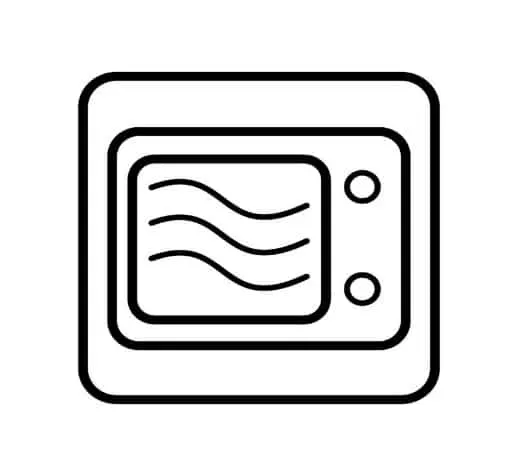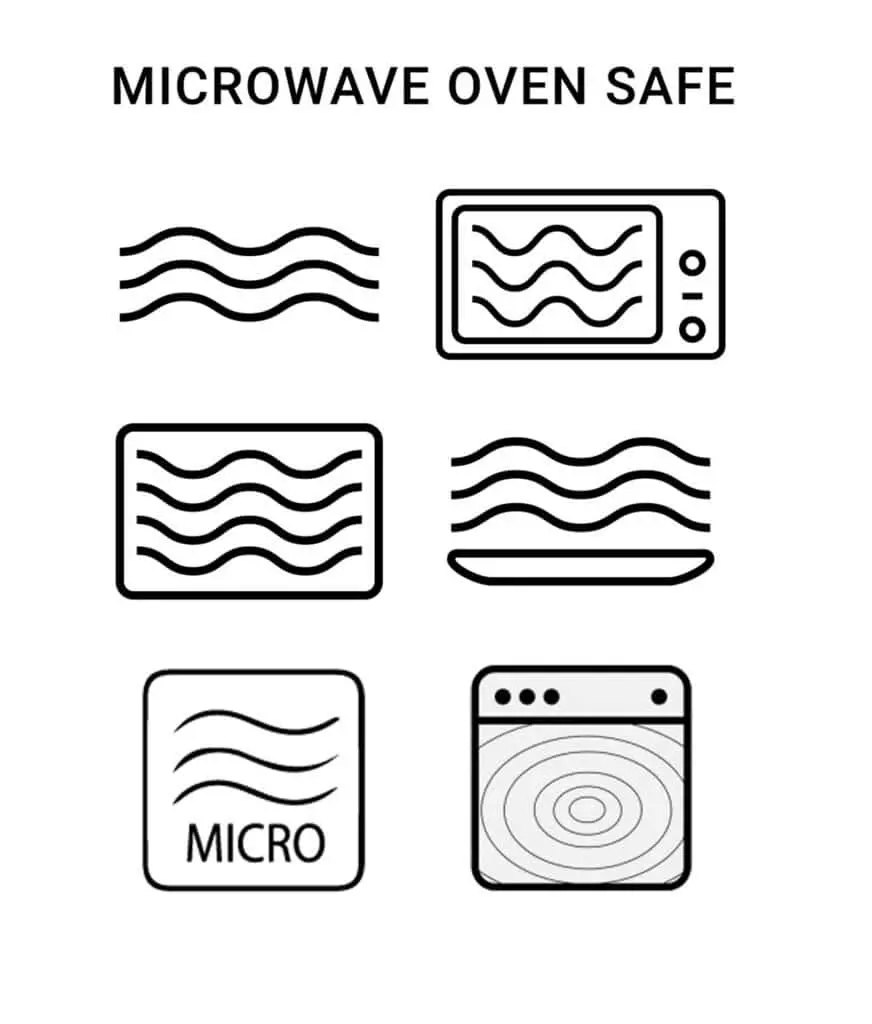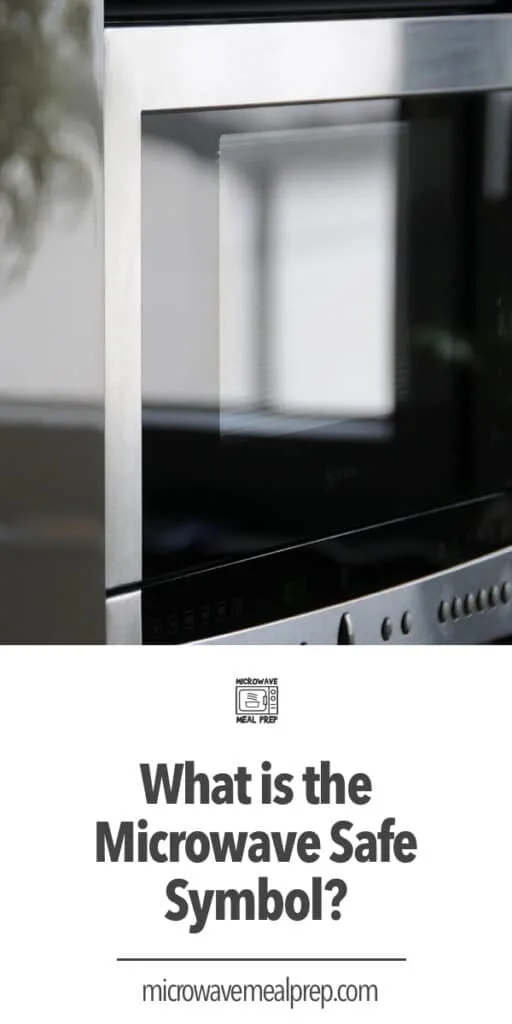A microwave safe symbol indicates compliance by the manufacturer that the product is safe to be used to heat food in a microwave. Are there universal microwave safe symbols and where can the be found?
What is the microwave safe symbol? Microwave safe symbols include 3 squiggly lines stacked on top of each other, a microwave logo with 3 wavy lines inside or recycling #5 indicated on plastic containers.
Microwave can be an ideal kitchen appliance for your busy family because it saves you time through absolute convenience. However, if you are not well versed or acquainted with this appliance, you may get confused when it comes to using it properly.
Additionally, you may question when choosing the right container to employ for your microwave heating needs. The good news is that it is no guessing game because microwave safe containers, dishes or products come with safety symbols or labels attached to them.
Safety symbols and labels mean that experts have tested and confirmed to fit industry standards. Therefore, prioritizing safety is an essential factor that needs to be addressed in our kitchen items because the wrong choice can lead to potential health issues.
This article seeks to guide you in identifying the microwave-safe symbols and give materials and plastics ideal for safe microwaving. Answered below are frequently asked questions about microwave safe symbols and everything you need to know about the representations used.
What does microwave safe mean?
Microwave safe highly stresses temperature and it means that the material used to make the dish or container will never directly heat up. This has everything to do with how a microwave works to heat up food.
A microwave heats water molecules by causing vibration that generates heat through friction. Therefore, a microwave required water molecules to heat, and if there is no water present than heat is near impossible.
Furthermore, to be microwave-safe means that container or dish has low water content in the material. As a result, the dish will not heat up and energy is directed entirely towards the food.
Bowls, containers, cups, plates and what not that are not microwave safe, may contain materials like metal or plastic that may not be safely microwaveable.
In general, glass and ceramic are both considered to be microwave safe materials. Pots that are made with borosilicate glass possess the unique benefit of being microwave and oven safe.
Also, the durability nature of microwave safe materials makes cooking and reheating very easy.
What materials are microwave safe?
Certain types of hard plastic, glass and ceramic are generally considered as microwave safe materials. Wood, metal and soft plastic are not safe for microwave use.
Discussed below are materials that are microwave safe. In case you are not sure or you don’t have one of the materials on this list handy, you can use the procedure below to test.
- Fill the container in question with 250 ml of cold water
- Heat in the microwave using maximum power for only 1 minute
- Carefully feel the container. If the dish is warm, avoid employing it for microwave. If the dish is cool to the touch, then it is most likely microwave safe
Microwave safe materials to consider using in your appliance
- Aluminum foil: A small amount that is smooth and free of wrinkles or creases may helps to shield your food when used in microwave. Metal is not a material that is considered safe to us in a microwave, but flat aluminum foil with sharp corners will not allow the microwave radiation to be trapped in the material, resulting in a minimal risk of catching fire. It may be used to cover parts of the meal to trap steam and prevent overcooking. Ensure that the foil is a couple inches away from the microwave wall to avoid arcing that can happen if the foil contacts the wall while the appliance is running.
- Dinnerware: Dinnerware is another microwave material that is only safe when you avoid using chipped or cracked dishes. It is common for bowls, cups and plates to be labeled as microwave safe on the bottom of the dish.
- Glass jars: When using a glass jar, remember to remove the lid, especially if it is metal. It is only used when heating meals that demand to be warmed. The reason is that glass jars may break when exposed to high heat.
- Glassware: Use only glass that is heat resistant. Just ensure that the glassware does not include metallic parts or elements. Again, avoid chipped or cracked dishes. Cold glass may shatter in the microwave if not properly tempered, therefore you should allow the glassware to come to room temperature before microwaving.
- Microwave cooking bags: These are also microwave-safe materials but you have to read and follow the manufacturer’s instructions. Be sure to make slits in the bag to allow the stream to escape. Never close the microwave bag with the metal tie that is enclosed in the packaging, those are reserved for oven use only.
- Plastics: There are plastics specifically tailored for microwave use. Be sure to use them by following the instructions given. The plastic you use must be labeled or have a symbol for safety. Reputable manufacturers like GladWare, Rubbermaid, Tupperware and Ziploc have designed microwavable plastic containers that can be used to reheat food in a microwave. However, some types of plastic containers can soften as your meal gets hot.
- Plastic wrap: Cling wrap is meant to cover food to help retain moisture, but it must be labeled as microwave safe if you want to use it inside a microwave. Never let the plastic wrap touch the food while it is microwaving as this can potentially leach harmful chemicals into your food. Leave the corner of the wrap open to allow steam to vent out so that the cover doesn’t explode.
Materials to avoid microwaving:
- Aluminum tray – This can cause arcing
- Metal utensils – Metal shield the microwave energy from reaching the food
- Paper bags – Can initiate fire in the microwave
- Wood – Wood dries up quickly and can crack or split
- Food carton – Can cause arcing if metal is weaved into the packaging
- Metal twist ties – Can cause fire or arching in the microwave

Which plastic is microwave safe?
Type #5 or polypropylene is the type of plastic that is generally considered to be microwave safe and is commonly used in many microwaveable food storage containers.
There are several plastics that are considered safe for microwave usage. To know which one, the secret is checking the label and understand what synthetic materials are used in each plastic.
On the bottom of the plastic container, look for the label ‘microwave safe’ word and if it is not included, look for a microwave symbol that represents safety.
Sometimes the “Resin Id Code” is used to indicate the type of plastic being used in the container. The number corresponds with the blend of synthetic plasticizers used to make the material.
To better understand which type of plastic is safe for microwaving, take a look at the recycling number on the bottom of the plastic containers.
The number directly indicates the type of plastic used to make the product:
- 1, 2, 4 are sometimes microwave safe.
- 3, 6, 7 are not microwave safe
- 5 is PP (polypropylene), and is considered to be plastic that is safe for microwave use.
Confirming the heating aspects of the material help you avoid melting or warping the plastic under microwave heat. Alternatively, confirming plastic safety means that you are avoiding health issues initiated from chemicals leaching into your food as it cooks.
For a plastic manufacturer to use these indicators on their product to show these safety symbols and labels, it must be FDA approved.
This means that it has undergone broad testing and expert data analysis. Therefore, if the plastic has these microwave safe indicators on the bottom of the containers, you can rest easy that it is safe under sensible conditions.
With that in mind, the next aspect that can make a significant difference is selecting high-quality and low-weight plastics. These aspects make the plastic hard to break and easy to carry.
What numbers are microwave safe?
Number 1, 2, 4, and 5 are considered to be microwave safe. However, you have to be careful when dealing with high-density polyethylene type 2, polyethylene terephthalate type 1, and low-density polyethylene type 4.
Overall, numbers 1, 2 and 4 are microwave safe due to their resistance to melting when in the microwave.These are safe, especially if a strengthening chemical is available to reinforce and hinder it from melting.
On the other hand, polypropylene type 5 is the best bet. Usually, it is indicated as microwave safe without much warning. This type is heat resilient and strong.
Surprisingly, it will even remain clear after being introduced to tomato sauce.
The plastic always feels cool after microwaving. Despite that plastics have petroleum compounds and therefore, increased higher temperatures will eventually lead to the leaching of chemicals into your food.
Numbers 3, 6, and 7 are never safe to use in the microwave. The materials are softer and have a lower melting point, making them susceptible to melting, warring and hazardous discharge into your food.
What is the symbol for microwave safe?

It is sometimes challenging to understand the symbols used to mean microwave safe. Most commonly used are the squiggly lines. This will depend because sometimes, it comes as a dish with radiation waves or can be an image of a microwave.
The constant symbol, therefore, is the squiggly lines, which means you can confidently reheat your food in the microwave with that dish.
If this microwave symbol is not present, then look for the phrase, ‘microwave safe’ or ‘safe for microwave use’ to be written on the bottom of the dish.
Plastic containers may not write the label or use a microwave safe symbol. Instead, plastics often use the resin id code or recycling number that is a system for indicating the type of plastic.

Microwave Safe Symbols: Final Thoughts
Owning a microwave is great, however you need to make sure that it is utilized safely in your house. Remember, better safe than sorry, therefore, all information discussed here about microwave safe symbols is very important.
The materials used to make the dish ware or container is extremely important when determining whether or not it is microwave safe.
Materials like glass, ceramic and certain types of hard plastic are considered safe to use in a microwave. On the other hand, soft plastics, wood and metals are not safe to microwave.
Microwave safe symbols are used to label the a dish as safe for microwave use. Microwave safe is either inscribed on the bottom of the dish, or a logo may indicate the same designation.
The microwave safe symbol is a square microwave logo with 3 squiggly lines inside the box. Other symbols used are 3 to 5 wavy lines stacked on top of each other.
Furthermore, the resin id code or recycle number are commonly used to indicate the type of plastic material. Numbers 1, 2 and 4 are generally considered safe to microwave, while number 5 is the safest.
That is everything that you need to know about microwave safe symbols. Before microwaving just any container or dish, check the bottom to see if it is labeled with a microwave safe symbol, and if not labeled accordingly, then it is best to find a different dish to use in the microwave.

Chuck
Friday 23rd of July 2021
Thank you for the picture of the microwave safe symbol. The article is great!